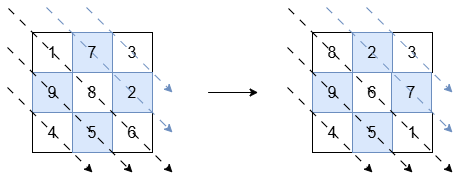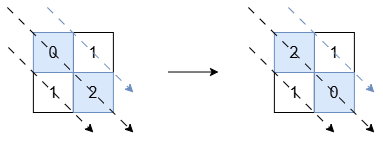| comments | difficulty | edit_url | tags | |||
|---|---|---|---|---|---|---|
true |
中等 |
|
给你一个大小为 n x n 的整数方阵 grid。返回一个经过如下调整的矩阵:
- 左下角三角形(包括中间对角线)的对角线按 非递增顺序 排序。
- 右上角三角形 的对角线按 非递减顺序 排序。
示例 1:
输入: grid = [[1,7,3],[9,8,2],[4,5,6]]
输出: [[8,2,3],[9,6,7],[4,5,1]]
解释:
标有黑色箭头的对角线(左下角三角形)应按非递增顺序排序:
[1, 8, 6]变为[8, 6, 1]。[9, 5]和[4]保持不变。
标有蓝色箭头的对角线(右上角三角形)应按非递减顺序排序:
[7, 2]变为[2, 7]。[3]保持不变。
示例 2:
输入: grid = [[0,1],[1,2]]
输出: [[2,1],[1,0]]
解释:
标有黑色箭头的对角线必须按非递增顺序排序,因此 [0, 2] 变为 [2, 0]。其他对角线已经符合要求。
示例 3:
输入: grid = [[1]]
输出: [[1]]
解释:
只有一个元素的对角线已经符合要求,因此无需修改。
提示:
grid.length == grid[i].length == n1 <= n <= 10-105 <= grid[i][j] <= 105
我们可以按照题目描述的要求,模拟对角线的排序过程。
我们首先对左下角三角形的对角线进行排序,然后对右上角三角形的对角线进行排序。最后返回排序后的矩阵即可。
时间复杂度
class Solution:
def sortMatrix(self, grid: List[List[int]]) -> List[List[int]]:
n = len(grid)
for k in range(n - 2, -1, -1):
i, j = k, 0
t = []
while i < n and j < n:
t.append(grid[i][j])
i += 1
j += 1
t.sort()
i, j = k, 0
while i < n and j < n:
grid[i][j] = t.pop()
i += 1
j += 1
for k in range(n - 2, 0, -1):
i, j = k, n - 1
t = []
while i >= 0 and j >= 0:
t.append(grid[i][j])
i -= 1
j -= 1
t.sort()
i, j = k, n - 1
while i >= 0 and j >= 0:
grid[i][j] = t.pop()
i -= 1
j -= 1
return gridclass Solution {
public int[][] sortMatrix(int[][] grid) {
int n = grid.length;
for (int k = n - 2; k >= 0; --k) {
int i = k, j = 0;
List<Integer> t = new ArrayList<>();
while (i < n && j < n) {
t.add(grid[i++][j++]);
}
Collections.sort(t);
for (int x : t) {
grid[--i][--j] = x;
}
}
for (int k = n - 2; k > 0; --k) {
int i = k, j = n - 1;
List<Integer> t = new ArrayList<>();
while (i >= 0 && j >= 0) {
t.add(grid[i--][j--]);
}
Collections.sort(t);
for (int x : t) {
grid[++i][++j] = x;
}
}
return grid;
}
}class Solution {
public:
vector<vector<int>> sortMatrix(vector<vector<int>>& grid) {
int n = grid.size();
for (int k = n - 2; k >= 0; --k) {
int i = k, j = 0;
vector<int> t;
while (i < n && j < n) {
t.push_back(grid[i++][j++]);
}
ranges::sort(t);
for (int x : t) {
grid[--i][--j] = x;
}
}
for (int k = n - 2; k > 0; --k) {
int i = k, j = n - 1;
vector<int> t;
while (i >= 0 && j >= 0) {
t.push_back(grid[i--][j--]);
}
ranges::sort(t);
for (int x : t) {
grid[++i][++j] = x;
}
}
return grid;
}
};func sortMatrix(grid [][]int) [][]int {
n := len(grid)
for k := n - 2; k >= 0; k-- {
i, j := k, 0
t := []int{}
for ; i < n && j < n; i, j = i+1, j+1 {
t = append(t, grid[i][j])
}
sort.Ints(t)
for _, x := range t {
i, j = i-1, j-1
grid[i][j] = x
}
}
for k := n - 2; k > 0; k-- {
i, j := k, n-1
t := []int{}
for ; i >= 0 && j >= 0; i, j = i-1, j-1 {
t = append(t, grid[i][j])
}
sort.Ints(t)
for _, x := range t {
i, j = i+1, j+1
grid[i][j] = x
}
}
return grid
}function sortMatrix(grid: number[][]): number[][] {
const n = grid.length;
for (let k = n - 2; k >= 0; --k) {
let [i, j] = [k, 0];
const t: number[] = [];
while (i < n && j < n) {
t.push(grid[i++][j++]);
}
t.sort((a, b) => a - b);
for (const x of t) {
grid[--i][--j] = x;
}
}
for (let k = n - 2; k > 0; --k) {
let [i, j] = [k, n - 1];
const t: number[] = [];
while (i >= 0 && j >= 0) {
t.push(grid[i--][j--]);
}
t.sort((a, b) => a - b);
for (const x of t) {
grid[++i][++j] = x;
}
}
return grid;
}
